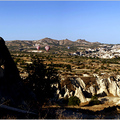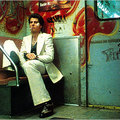
ARE you nuts?” The Royal Shooting Club's ancient caretaker was furious with me. Wandering the club's secluded public gardens above the beach three miles north of Copenhagen, I had stumbled onto a well-manicured range whose target was hidden in a hedge some 200 feet from a high-powered rifle mounted in the club's dining veranda. “You see?” the caretaker said, cooling off and taking me inside to show me the walls filled with portraits of Danish nobles and members' coats of arms. “This is an old place with fine traditions. All the people wandering through here could end things in a minute.”
I should have been dumbfounded to see such an incongruous sight in the crowded suburbs of liberal Copenhagen, but this was, after all, the Whiskey Belt, where the rules of Denmark's traditional egalitarianism don't always apply.
Whiskey Belt is the nickname for the narrow strip of beaches, forests, pleasure gardens and villas that dot the 25 miles of coastline from Copenhagen's northern reaches to Hamlet's castle of Kronborg in Elsinore. Some of Denmark's most prominent citizens live here, facing the country's traditional enemy, the Swedes, on the other side of the narrow Oresund strait, and a steady onslaught of Copenhageners coming up here to unwind.
“ ‘Whiskey Belt' is sort of a bad name for the place, but it's popular,” said Joachim Knop, a Danish opera star who makes his home along the coast. “The idea is that people in Copenhagen drink beer, while life on the north side is so good, we all drink whiskey.”
Perhaps the ultimate compliment to this area is the name of a coming prime-time TV melodrama about the travails of a wealthy Whiskey Belt family: “2900 Happiness”— 2900 being the principal postal code for the Whiskey Belt. “For Danes 2900 is sort of like Beverly Hills 90210,” said Sofie Lassen-Kahlke, who stars in the show and who herself grew up here. “It's where Denmark's most expensive homes and highest salaries are to be found. There's a mystique to the place.”
A single artery, Strandvejen, curves through the area like a Danish version of the Pacific Coast Highway. During the weekends and evenings Strandvejen's bike paths are jammed with inline skaters and bikers heading up to the beaches, getting exercise or simply checking out the scene. Copenhagen's mass transit system, the S-train, also has a “Coastal Line” for commuters, explorers and urban invaders.
The most glamorous part of the coast is six miles north of Copenhagen's center, when you round the bend at Klampenborg and see the bay dotted with Victorian villas and low modern apartment buildings whose white facades and curving forms reflect the seascape. Most striking of all is a formidable mansion with a green-topped cupola hovering on a low hill above the bay. This is Hvidore, where the Danish-born Empress Dagmar of Russia, whose son Czar Nicholas II was murdered after the Russian Revolution, fled with her jewelry and her Cossack guards. From her widow's walk she could gaze across the sound toward Russia, somewhere beyond the Swedish coast. Her gaze is now mirrored by a statue of Knud Rasmussen, the Danish polar explorer, which permanently stares at Sweden from his granite beachside pedestal beneath the mansion.
There's a lot to stare at here. This stretch of road fronts Bellevue Beach, whose summer inhabitants tend to be as sexy, though more blond, than those at Copacabana. And practically every 20th-century structure you see here was designed by Arne Jacobsen, whose organic buildings and furnishings defined Danish Modern for the rest of the world. Jacobsen lived and worked in the Whiskey Belt for most of his career. He even designed the funky white-tiled gas station — now an ice cream parlor — with its George Jetson-ish toadstool awning in front of Skovshoved harbor.
But for me the coolest of Jacobsen's designs is Bellevue Beach itself, with its cartoonish blue-striped lifeguard towers and white geometric kiosks, which, when they were built in 1932, must have seemed half a century before their time.
Time travel does seem possible in the Deer Park, behind the beach. This is probably Denmark's most popular and certainly most populist green spot despite having been a royal hunting ground for three and a half centuries. Cross under the royal crest on the red wooden gate next to Klampenborg Station and enter into an ancient forest worthy of Hansel and Gretel. Some 2,000 deer stride freely around this fenced-in hilly terrain more than three times the size of Central Park, amid massive trees that make other forests seem pygmy-like.
“The trees here are unusually tall because after Denmark lost its navy to the British in the early 1800s, they decided to plant lots of oak and beech trees here for use in building future ships,” said Ingvar Sahlberg, who manages Pieter Lieps Hus restaurant, a popular excursion point for people wandering the forest. “They just never got around to chopping them down.”
Walking past Lieps at night takes you to a surreal sight: Half a mile into the dark woods you come upon a colored light bulb riot of beer gardens, rides, theaters and even a wooden roller coaster. This is Bakken, which bills itself as the world's oldest amusement park. Started in the early 18th century when jugglers, troubadours, clowns and other entertainers began setting up their tents around a holy spring, Bakken remains a boisterous place where Copenhageners flock to eat greasy food, take thrill rides, drink lots of beer and watch risqué cabarets. Bakken's setting in these pricey bucolic surroundings would be a little like bringing Coney Island to Montauk.
“Bakken is bawdier, more folksy, cornier and a lot older than Tivoli,” said Anne Kjeldsen, referring to Copenhagen's famous amusement park. Ms. Kjeldsen owns the Skovly, a colorful restaurant and beer garden in Bakken; keeping with tradition, she and the park's other business owners are still called “tent holders.” “Bakken's got more soul,” she said.
The most famous meal in Bakken is fire, eaten several times a day in front of a little green house inhabited by the park's mascot clown, Pjerrot. Beloved by several generations of Danes, Pjerrot is a character out of Italian comic opera who has been entertaining Bakken's visitors since 1800. He is essentially a set of oversized red lips cracking jokes from a sea of white makeup and clothing. Tivoli also adopted Pjerrot as a mascot, but the difference between the two says it all: Bakken's Pjerrot sings, does tricks and, yes, eats lots of fire; Tivoli's Pjerrot performs in a ballet.
If one seeks deeper refinements, drive 10 minutes north to Louisiana (Gammel Strandvej 13, Humlebaek; 45-4919-0719; www.louisiana.dk; entry 80 kroner, or $14.50 at 5.5 kroner to the dollar), one of Europe's most prominent modern-art museums. It was named, according to legend, by a former owner of the museum's grounds who had three wives named Louise. Few places better epitomize the Whiskey Belt's unique blend of populism and elitism. Part modern museum and part leisure park, Louisiana is a series of pavilions linked by glass walkways along a fantastic garden overlooking the Oresund. When I was there in early June, there was a provocative multimedia exhibit on modern Chinese art alongside the museum's permanent “Best of the 20th Century” collection. But the star of Louisiana is the amazing outdoor surroundings, and most visitors were sunbathing in the seaside garden while their kids tottered about the lawn among the Giacomettis and Calders.
Just down Strandvejen, in Rungsted, lies the creation of another artist. Like Empress Dagmar, Karen Blixen returned to the Whiskey Coast as an exile in her own land. In 1931, divorced from her husband, rejected by her lover, broke and humiliated by the failure of her coffee plantation in Kenya, Blixen moved back with her mother at Rungstedlund to do the only thing that was left for her to do: write. Here on her father's old slanted desk is where she wrote “Out of Africa,” “Babette's Feast” and most of the other tales that would put her on the world literary stage under her pen name, Isak Dinesen. Rungstedlund is now a museum (Rungsted Strandvej 111; 45-4557-1057; www.isak-dinesen.dk; entry 45 kroner), and its densely planted park provides a captivating glimpse at the other talents Blixen cultivated, literally.
Wandering around the park's 40 acres of groves and perennial-filled gardens is like taking a botanical tour of Denmark. Blixen grew herbs, flowers and shrubs from all over the Danish isles here. Ever true to her aristocratic aspirations, she had trees from Denmark's major estates replanted throughout the grounds. But, like a true citizen of the Whiskey Belt, she gave her blue-blooded ideals a populist slant. Four years before she died in 1962, she converted the estate into a bird sanctuary after encouraging the Danish public to donate one krone each to the cause. Some 80,000 Danes complied, and now the park is a popular walking and picnicking area. Blixen herself is buried beneath a giant beech tree at the northern end of the grounds.
From this spot, perched between the forest and the sea, the sight of a rainbow of wildflowers mingles with birdsong. Contemplating this perfect slice of nature at the edge of Copenhagen, a visitor can easily see how Blixen could have written “Out of Africa” here. It's also easy to see why she never went back.
VISITOR INFORMATION
HOW TO GET THERE
Scandinavian Airlines, United and Continental offer flights from Newark Airport to Copenhagen. An Internet search for August flights found S.A.S. round-trip fares starting at $627.
The A, E, F and C lines on the S-Train — Copenhagen's efficient mass-transit system — run along the northern coast (110 Danish kroner, or $20 at 5.5 kroner to the dollar, for a 24-hour ticket). Bakken, Dyrehavsbakken and Bellevue Beach are all gathered around Klampenborg station. The Karen Blixen Museum is a 15-minute walk from Rung-sted station, and the Louisiana museum is a 10-minute walk from Humlebaek station.
Bikes are an excellent way of getting around. There are paved paths along Strandvejen, and bikes can be taken on and off the S-trains (10 kroner extra). Rentals can be had at two central city Rent a Bike locations through www.rentabike.dk; (45) 3333-8613. A bike is 75 kroner a day, with a 500 kroner deposit.
WHERE TO EAT
Strandmoeller Kroen, built on the site of a 500-year-old paper mill, is a favorite with city folk looking for a quaint taste of country. A lunch plate with local specialties like pickled herring, sautéed flounder and Danish cheese is 158 kroner. Strandvejen 808; (45) 3963-0104; www.strandmoellekroen.dk.
Peter Lieps Hus, a straw-roofed former gamekeeper's cottage in the Deer Park next to Bakken amusement park, serves Danish classics like biksemad, a stew with potatoes, pork, onions and egg (116 kroner). Dyrehaven 8; (45) 3964-0786; www.peterliep.dk.
Restaurant Jacobsen, a chic restaurant next to Bellevue Beach, is a tribute to all things Arne Jacobsen from the building itself to the furniture, framed blueprints and even the cutlery. A three-course tasting menu with wine is 565 kroner. Strandvejen 449; (45) 3963-4322; www.restaurantjacobsen.dk.
WHERE TO STAY
Skodsborg Kurhotel, a former royal residence about 10 minutes' walk to the Deer Park and the sea, is now a hotel and a popular spa for well-heeled locals; 1,600 kroner for two, breakfast included. Skodsborg Strandvejen 139; (45) 4558-5800; www.skodsborg.dk.
Skovshoved Hotel is a romantic inn with an excellent restaurant; 1,400 kroner for a double room. Strandvejen 267; (45) 3964-0028; www.skovshovedhotel.dk.






